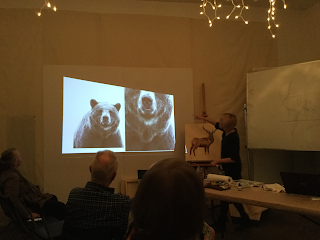There's no doubt about it, if you want to be a full time artist, eventually you are going to have to do a demo. The first time I did a demo it was on a scorching hot day in July and I was painting in fast drying acrylics "Plein Air": Certainly a trial by fire.
There are different kinds of demos
Demo at a show or event, which is all about painting and just needs courage and supplies.
Demo with talk, which is more varied and needs to be well prepared.
This is a check list of things to do to prepare for a demo with a talk. Remember people are there to see you paint, so keep the talk to 30 mins and demo at least 30 mins. Be brave and remember that people are already on your side by showing up. They want you to succeed. As well as an intro you will also be talking when you paint, but that will be about process and answering questions. Leave time at end to answer personal questions.
A list of good traits and bad traits in presenting.
Good - Sound knowledge, prepared, on topic, open and sharing, engaging, good voice and pace,
starting on time
Bad - Boring, no control, poor voice and speaking, knowledge of equipment, not set up.
PREPARATION
1. (a) Pick a topic and a catchy title
Something you're passionate about
Something you are knowledgeable about
Something people are interested in -
Personal discoveries, techniques
Don't have too broad a topic
Possible Topics
Light and shadow
Perspective
Finding style
Composition
Techniques
Fur and feathers
Depth in water
1. (b) e.g Negative Painting for Positive Results
2. Collect material
Progress photos including prep drawings
Any visual material
What inspires you
Supplies and equipment
Slide show - 10 - 20 slides - no more than 6 bullets on each page, no more than 6 pages - not longer than 30 mins
3. Create short bio
How you took up art
Your personal journey as it relates to your art
Successes and failures
Keep it brief and think about what people want to hear not a list of achievements
4. Prepare an outline
Place everything in a folder on computer (make sure to number in order)
Focus on topic and gather visual aids
keep adding ideas - better to have too much than too little
Organize
Create Structure
Illustrations
Visual elements
Handouts
5. Prepare for Tangents
Questions - Answer question and return to topic
List of supplies
Knowledgeable hijackers - Thank them and go to topic
Balance time versus interest
6. Assemble items
Power cord, lights
Several progress paintings to work on
Bring finished work
7. Plan Room
Best way to seat people
Rear tilted mirror
Easel (blocking view, which side to stand)
How equipment works
Arrange visual aids in order
Size of demo piece? According to size of room
8. The Demo
Be organized with tools and visuals
Paint for at least 30 mins
It's easier to prepare several progress canvases
Answer questions
Pass things around
Ending - allow people to come up and see
Answer questions
Leave time for off topic questions to be addressed personally




















No comments:
Post a Comment